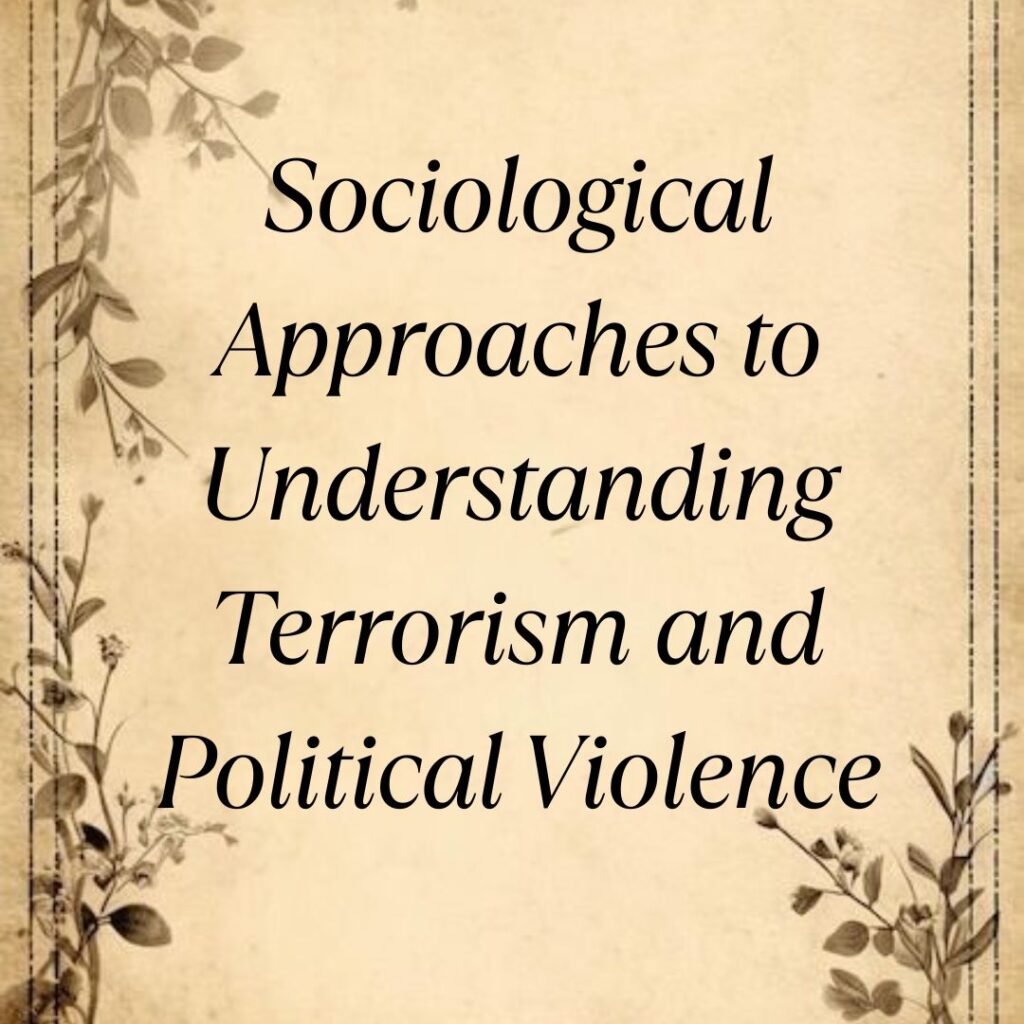Terrorism and political violence are among the most pressing issues of our time, often dominating headlines and shaping global politics. Yet, understanding these phenomena requires more than just surface-level analysis; it demands a deep dive into the sociological underpinnings that drive individuals and groups to commit acts of violence. Let’s explore the sociological approaches that shed light on why terrorism and political violence occur, using relevant examples to illustrate these complex dynamics.
What is Terrorism?
Before delving into sociological theories, it’s crucial to define what we mean by terrorism. Terrorism is typically understood as the use of violence and intimidation, especially against civilians, in the pursuit of political aims. Political violence, on the other hand, encompasses a broader range of violent acts, including state-sponsored violence, civil wars, and insurgencies. Both are deeply intertwined with social, political, and economic factors.
Structural Strain Theory: When Society’s Pressures Boil Over
One way sociologists explain terrorism is through structural strain theory, developed by Robert K. Merton. This theory suggests that societal structures may pressure citizens to commit crimes. When legitimate means of achieving goals (such as education or employment) are inaccessible, people may turn to deviant behaviors, including terrorism, to achieve their objectives.
Example: The Arab Spring, which began in 2010, saw a wave of protests across the Middle East and North Africa. High unemployment, political corruption, and a lack of social mobility created immense strain in these societies. In countries like Tunisia and Egypt, this strain boiled over into uprisings. In some instances, where peaceful protest seemed ineffective, factions turned to violence to make their voices heard.
Social Identity Theory: The Power of Group Dynamics
Social identity theory, proposed by Henri Tajfel, helps us understand how group dynamics contribute to terrorism. This theory posits that people derive a sense of identity and self-esteem from their group memberships. When individuals strongly identify with a group, they are more likely to conform to its norms and values, even if those include violent actions.
Example: Consider the case of ISIS. Many foreign fighters who joined ISIS did so because of a strong identification with the group’s ideology and a desire to belong to something larger than themselves. The allure of camaraderie, purpose, and the promise of a utopian Islamic state motivated individuals from various parts of the world to participate in acts of terrorism.
Relative Deprivation Theory: When Expectations Meet Reality
Relative deprivation theory, developed by sociologist James C. Davies, explains that people resort to violence when there is a significant gap between their expectations and their reality. When individuals or groups feel deprived relative to others or compared to their own expectations, frustration can lead to aggression.
Example: The Troubles in Northern Ireland (late 1960s-1998) are a poignant example. The Catholic minority felt relatively deprived compared to the Protestant majority, facing economic disadvantages and political exclusion. This perceived deprivation fueled the violent conflict between the Irish Republican Army (IRA) and British authorities.
Radicalization: A Step-by-Step Process
Understanding terrorism also involves examining the process of radicalization. Radicalization is the process by which individuals come to adopt extreme political, social, or religious ideologies, often leading to the endorsement of violence. This process can be broken down into several stages:
- Pre-Radicalization: Individuals feel disconnected or disillusioned with their current situation.
- Self-Identification: They begin to explore alternative beliefs and join like-minded groups.
- Indoctrination: They fully adopt extremist beliefs, often reinforced by group leaders.
- Jihadization (or action): They decide to engage in violent acts to advance their cause.
Example: The Boston Marathon bombing in 2013 was carried out by brothers Tamerlan and Dzhokhar Tsarnaev. Their radicalization process involved a mix of personal grievances, exposure to extremist ideologies online, and a sense of belonging to a larger cause. The internet and social media played a crucial role in their indoctrination.
State-Sponsored Terrorism: When Governments Turn to Violence
While much focus is given to non-state actors, state-sponsored terrorism is also a significant aspect of political violence. States may use terrorism as a tool to suppress dissent, destabilize rivals, or maintain control over their population.
Example: The Syrian Civil War saw the Assad regime employing state-sponsored terrorism to retain power. This included the use of chemical weapons against civilian populations, which not only terrorized the populace but also aimed to demoralize opposition forces.
The Role of Media: Amplifying the Impact
The media plays a dual role in terrorism and political violence. On one hand, it informs the public and brings attention to issues. On the other, it can amplify the impact of terrorist acts by spreading fear and panic, which is often the goal of terrorists.
Example: The 9/11 attacks were not just about the immediate devastation but also about the global fear and insecurity they generated. Media coverage of the attacks and their aftermath played into the terrorists’ hands by ensuring their message reached a worldwide audience, magnifying the psychological impact.
Globalization: A Double-Edged Sword
Globalization has interconnected the world in unprecedented ways, but it has also facilitated the spread of extremist ideologies and terrorist networks. The ease of travel, communication, and financial transactions has allowed terrorist organizations to operate transnationally.
Example: Al-Qaeda’s operations spanned multiple countries, from Afghanistan to the United States, with cells and affiliates in various regions. Globalization enabled the group to recruit, plan, and execute attacks across borders, demonstrating how interconnectedness can aid terrorist activities.
Conclusion: A Multifaceted Challenge
Understanding terrorism and political violence requires a multifaceted approach. Sociological theories such as structural strain, social identity, and relative deprivation provide valuable insights into why individuals and groups resort to violence. Additionally, the processes of radicalization, state-sponsored terrorism, and the role of media and globalization are crucial components of this complex puzzle.
In a world where terrorism and political violence continue to evolve, it is essential to stay informed and critically analyze these issues. By doing so, we can better address the root causes, implement effective counterterrorism strategies, and work towards a more peaceful and just global society.







